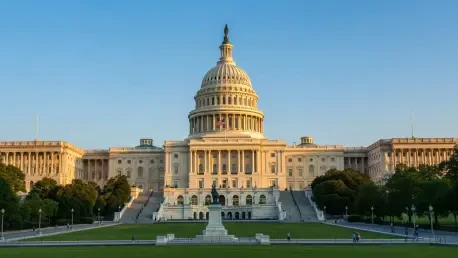Setting the Stage: A Sector in Crisis
The U.S. travel and hospitality industry, a cornerstone of the national economy, finds itself grappling with an unprecedented challenge in 2025 as a prolonged government shutdown disrupts operations and dampens consumer confidence. This sector, which contributes significantly to GDP and supports millions of jobs, faces a critical test as the deadlock in Washington over funding extends into its fourth week. The ripple effects are palpable, with hotels reporting empty rooms, airlines bracing for fewer bookings, and tourism hotspots feeling the strain of reduced foot traffic. This crisis raises pressing questions about the resilience of an industry so vital to economic stability.
Beyond the immediate financial toll, the shutdown threatens to alter travel patterns and business behaviors in ways that could linger for months. Key players, from major hotel chains to leading airlines, are sounding alarms over declining demand, particularly for corporate and government-related travel. As the situation unfolds, this report delves into the multifaceted impacts on the industry, examining both the direct consequences and the broader economic implications of this ongoing impasse.
Overview of the Travel and Hospitality Industry Amid the Shutdown
Current State and Economic Significance
The travel and hospitality sector remains a powerhouse in the U.S. economy, accounting for a substantial share of GDP and employing millions across hotels, airlines, restaurants, and tourism services. This industry not only drives direct revenue but also supports ancillary businesses, from local vendors to transportation providers. Its economic weight makes any disruption particularly consequential, as seen in the current government shutdown’s widespread effects on consumer spending and business activity.
Vulnerability to such crises is inherent in this sector due to its reliance on discretionary spending and stable government operations. Hotels, for instance, depend on consistent bookings from both leisure and corporate travelers, while airlines face tight margins that falter with even slight drops in demand. Tourism, especially in areas tied to federal landmarks or government business, suffers when access or funding is curtailed, amplifying the shutdown’s impact across these interconnected segments.
Major Players and Immediate Impacts
Prominent companies like Hilton Worldwide and United Airlines are at the forefront of navigating this crisis, with leadership expressing deep concern over the immediate fallout. Hilton’s Chief Financial Officer has publicly noted a downturn in travel demand, reflecting the broader anxiety within the sector about sustained revenue losses. United Airlines, similarly, has flagged potential disruptions to bookings and operational efficiency as the shutdown persists.
The scope of this crisis extends beyond individual firms, affecting consumer spending habits and the critical area of business travel. Corporate trips, often tied to government contracts or meetings, have seen sharp declines, while leisure travelers hesitate amid economic uncertainty. This dual impact on both personal and professional travel underscores the pervasive nature of the shutdown’s influence on industry health.
Direct Effects of the Shutdown on Travel and Hospitality
Reduced Demand and Revenue Losses
A marked reduction in travel demand stands as one of the most visible effects of the current government shutdown, with corporate and government-related bookings taking a significant hit. Many businesses have postponed non-essential travel, while federal employees, often key clients for hotels and airlines, face furloughs or delayed paychecks, curbing their spending. This contraction in demand translates directly into lost revenue for an industry already operating on thin margins.
Specific examples highlight the severity of these losses, such as Hilton revising its room revenue growth forecast downward for the current year. This adjustment signals not just a temporary dip but a broader concern about sustained booking declines if the funding deadlock continues. Across the sector, firms are recalibrating expectations as they brace for a prolonged period of reduced activity.
Regional Disparities and Hotspot Challenges
The impact of the shutdown is not uniform, with certain regions bearing a heavier burden due to their reliance on government-driven business. Washington, D.C., emerges as a prime example, where hotels are significantly underperforming compared to national averages. The absence of federal workers and halted government operations have left local hospitality businesses struggling to fill rooms and maintain revenue streams.
Data from past shutdowns provides context for this disparity, with analysts noting that D.C.-area hotels experienced revenue per available room lagging by approximately 8 percentage points behind the rest of the country during similar crises. This trend, compounded by tough year-over-year comparisons, paints a grim picture for the region’s hospitality sector, which faces unique challenges tied to its proximity to federal operations.
Operational and Logistical Challenges in the Industry
Staffing Shortages at Federal Agencies
Operational hurdles are mounting as staffing shortages at key federal agencies exacerbate the shutdown’s toll on travel. Industry groups, including the U.S. Travel Association, have raised alarms about reduced personnel at the Transportation Security Administration (TSA) and the Federal Aviation Administration (FAA). These shortages threaten to disrupt critical services that keep the travel infrastructure running smoothly.
The potential consequences are significant, with longer airport wait times and flight delays likely to deter travelers. Such disruptions not only frustrate passengers but also strain airlines and airports, which must manage increased operational costs and customer dissatisfaction. This bottleneck effect could further dampen travel demand at a time when the industry can ill afford additional setbacks.
Economic Ripple Effects and Weekly Losses
Beyond immediate operational issues, the shutdown’s economic ripple effects are staggering, with estimates suggesting potential losses of $1 billion per week in travel spending if disruptions escalate. This figure captures the cascading impact on hotels, airlines, and local economies that depend on tourism dollars. The loss of such revenue threatens not just corporate balance sheets but also the livelihoods of countless workers in the sector.
Broader implications include a decline in consumer confidence, as uncertainty about the economy prompts households to cut back on discretionary expenses like travel. Postponed business activities further compound the issue, as companies delay meetings and events, creating a vicious cycle of reduced spending and economic stagnation that reverberates through the industry.
Regulatory and Financial Hurdles Exacerbated by the Shutdown
Impact on Financial Operations and Approvals
The shutdown’s reach extends into regulatory and financial domains, creating obstacles for travel and hospitality firms indirectly tied to government processes. The U.S. Securities and Exchange Commission (SEC), for instance, has halted approvals for registrations and listings, affecting companies across sectors. This gridlock disrupts financial planning and transactions that underpin business confidence and investment in travel-related enterprises.
Delays in government expenditures also play a role, impacting firms like Thermo Fisher, which rely on federal contracts. These delays create a domino effect, as reduced government spending limits the resources available for business travel and related activities. The interconnected nature of these financial hurdles underscores how deeply the shutdown permeates economic operations.
Uncertainty Stifling Business Planning
Uncertainty stands as a central challenge, with the ongoing deadlock in Washington hindering strategic planning for travel and hospitality companies. Without clarity on when or how the shutdown will resolve, firms struggle to make informed decisions about staffing, investments, or marketing campaigns. This paralysis at the planning level risks long-term stagnation in an industry that thrives on forward momentum.
Shared concerns across industries amplify this issue, as leaders from various sectors echo the travel industry’s frustration over the broader economic toll. The lack of predictability not only affects day-to-day operations but also erodes trust in the stability of the market environment, making recovery a more daunting prospect for affected businesses.
Future Outlook: Prolonged Shutdown Risks and Recovery Prospects
Short-Term Threats and Industry Adaptation
If the shutdown extends further, the short-term threats to the travel and hospitality sector could intensify, with deeper revenue declines and operational inefficiencies on the horizon. Hotels and airlines may face increased pressure to slash rates or cancel services, further eroding profitability. The immediate future hinges on the duration of this crisis and the industry’s ability to weather sustained disruptions.
Adaptation strategies are already emerging, with companies like Hilton implementing cost-cutting measures and revising financial forecasts to mitigate losses. Such actions, while necessary, reflect a defensive posture that prioritizes survival over growth. The sector’s resilience will be tested as it navigates these uncharted waters with limited visibility into resolution timelines.
Long-Term Implications and Economic Recovery
Looking further ahead, a prolonged shutdown risks lasting damage to consumer confidence and entrenched shifts in travel behavior. If travelers grow accustomed to postponing trips or opting for alternative destinations, recovery could lag even after federal operations resume. This potential for altered patterns poses a significant concern for an industry reliant on consistent demand.
Recovery prospects will depend on several factors, including the speed of political resolution and the state of global economic conditions. A swift end to the deadlock could spur a rebound, bolstered by pent-up demand, but external pressures like inflation or geopolitical tensions may complicate the path forward. The sector’s ability to rebuild trust and adapt to evolving consumer preferences will shape its long-term trajectory.
Final Reflections: Charting a Path Beyond the Crisis
Looking back, the government shutdown of 2025 inflicted considerable strain on the travel and hospitality industry, revealing vulnerabilities in a sector critical to economic vitality. Revenue losses, operational disruptions, and regulatory delays painted a challenging landscape for businesses ranging from hotel giants to regional tourism operators. The crisis underscored the interconnectedness of federal stability and industry health, leaving lasting impressions on corporate strategies and consumer mindsets.
Moving forward, actionable steps emerged as essential to mitigate further damage and foster recovery. Policymakers were urged to prioritize rapid resolution of funding disputes, while industry leaders explored innovative partnerships and digital solutions to rebuild traveler confidence. Government support, through targeted relief or streamlined regulatory processes, was seen as a potential catalyst for renewal. These considerations offered a roadmap for navigating beyond the immediate fallout, emphasizing adaptability and collaboration as cornerstones for restoring the sector’s strength in the years that followed.









